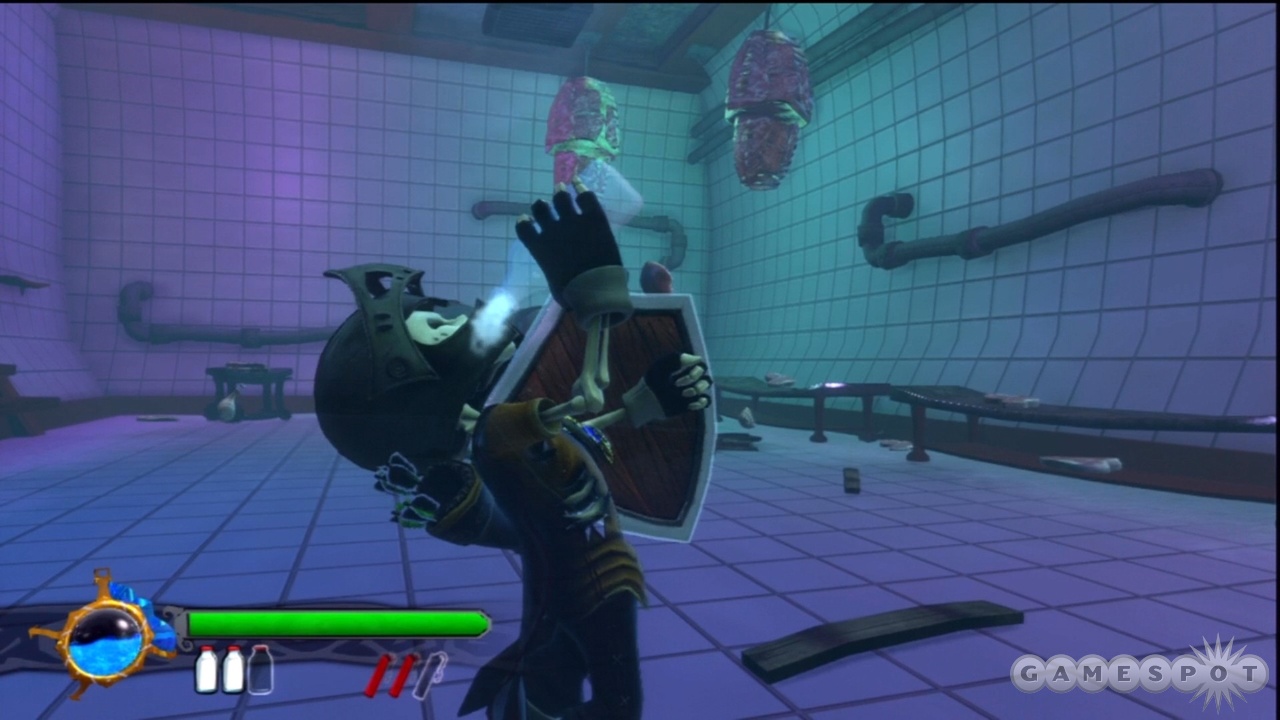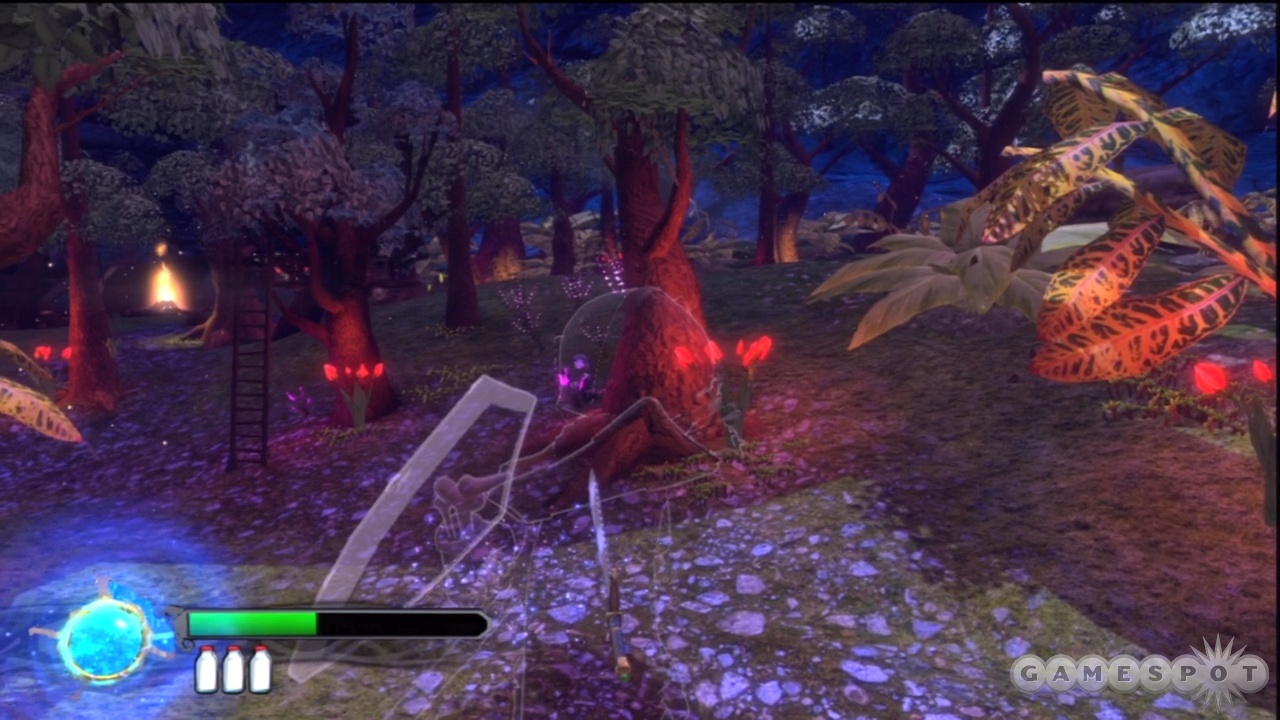Deadmund, nee Edmund before he was turned into a skeleton, is a precocious boy with a thirst for milk and violence, though not necessarily in that order. When confronted by a bone-white gang of the living dead, he dispatches them with dynamite or skewers them pointy weapons, growing stronger from every being he vanquishes. Hundreds of his cursed brethren fall to your deadly wrath on your way to the head bad guy who has caused you so much trouble, though by the time this face-off occurs, you'll have long grown tired of the repetitive action dragging you down. The novelty of transforming your PlayStation Move into a variety of deadly weapons fades shortly into Medieval Moves: Deadmund's Quest, leaving a bitter taste in your mouth as you slog through this haphazard adventure.
Deadmund doesn't particularly like being a skeleton. Growing tired of seeing a lifeless skull staring back at him when he looks in the mirror, Deadmund gathers his trusty weapons in search of a powerful amulet that promises to cure what ails him. Deadmund's Quest has a charming appeal that makes your travels immediately engaging. A variety of locales plucked from the Middle Ages serve as the backdrop, and each place you visit, from creepy crypts to unsanitary kitchens, provides its own visual rewards. Though far from a technical marvel, the endearing artistic design could have been torn from the pages of a lovable children's book. However, the same cannot be said for the story. Though there are silly jokes to enjoy, the storyboard cutscenes lack the rich artistry that could have brought these characters to life.
Deadmund's Quest is an on-rails adventure that requires the PlayStation Move. Your point of view is affixed behind Deadmund, though his skeletal frame is transparent so you don't have to worry about him getting in the way. He walks where he wants, when he wants, and camera shifts line up enemies in your sights. The walking portions let you enjoy the view, and there are hidden collectibles you can snag while traveling from one location to the next. However, the majority of the game takes place once you stand still. When you do, enemies rush at you from a variety of angles, and you use one of your four attacks to dispose of them. You have access to a sword, ninja stars, a bow and arrow, and dynamite most of the time (dynamite is the only weapon that has a finite supply), and you switch between them by moving the controller in certain ways.

It's a smooth system that works most of the time. Your sword is your most used weapon and is therefore the easiest to use. Simply moving your arm results in a swing, and the game does a good job of mirroring your attacks. If you prefer an overhead smash, feel free to knock those nasty skeletons on the head every time they come too close. You're rarely forced to move with precision, so as long as you flail your arm with vigor, you should knock your enemies out with no problem. When you reach your arm behind your back, you can pluck an arrow from your quiver. It's fun mowing down attackers from afar, though the aiming execution is lacking. For instance, there are some skeletons that hide behind shields, periodically peeking out to sling projectiles at you. If you point directly at their bodies when they're exposed, your arrow sticks in their shield, so you have to point off to the side of their bodies to actually make contact. Also, the game often takes a second or two to bring up the aim reticle after you've notched your bow. These are small annoyances, but they frustrate nonetheless.
By flinging your arm forward, you toss ninja stars. Like with the arrows, you have an infinite supply of these, which is a good thing because accuracy is tough to achieve. Trying to hit a small target far off in the distance is nigh impossible, though they come in handy when you don't have time to ready an arrow. Your last weapon is dynamite, and though this is used the least, its implementation is the cleverest. To light the fuse you have to cover the glowing ball at the top of the controller, simulating how you would shield the flame from wind in real life. Aside from using weapons, there are a couple of other motions you need to perform. Tilting the controller toward your mouth lets you drink revitalizing milk, though this takes a couple of seconds to register, which could lead to your untimely demise. Finally, by holding the controller to your belt, you activate your amulet, which makes every weapon stronger. Bafflingly, though the motion for this is quite easy to perform, it doesn't always trigger like it should, which can be infuriating when monsters are swarming around you.
The early moments of this game make fine use of the cartoony visuals and immersive controls to suck you into Deadmund's journey. Using your shield to protect yourself from your adversaries' blows and then retaliating with a sword strike of your own embodies the goofy fun the Move controller exudes at its best, and there are enough secrets tucked away in the environment to make shooting your bow recklessly into the background rewarding. However, things begin to fall apart after you tear through a few levels. There's an unrelenting feeling of predictability that suffocates the carefree charm. Despite the change in settings and enemy types, you perform the same basic actions over and over again until the joy has been washed cleanly away. There are only so many times you can bash a skeleton with a sword before your actions lose all meaning, and the uninteresting puzzles and other such interludes fail to ameliorate the repetition.

It's when the difficulty ramps up in the later levels that the wheels completely fall off this wagon. Deadmund's Quest does a lousy job of balancing combat scenarios. Your only line of defense is your trusty shield, though because hunkering down behind it makes you a passive participant in events, you are at the whims of problematic enemy placement. Three arrow-shooting enemies may line up before you, and because their timing is such that your shield is being hit every second, there's no opportunity to mount your own attack. Your only option is to get hit while you ready your own shot, and being forced to take damage results in untold aggravation. Other times, you may have to fight melee and ranged attackers at the same time, monsters that obscure your vision, or pilots who unleash missiles at you, and all of these situations suffer from the same glaring issue. Because you cannot dodge or deflect attacks, you have to take damage if you're going to dish out some of your own.
Two-player competitive and cooperative modes are available if you can stomach more of this adventure once the ending credits roll, but the shallow combat ensures you won't want to spend any more time with this game than you have to. Performing the same actions ad nauseam could make for an entertaining experience if diverse combat scenarios broke up the monotony, but such is not the case here. You swing your sword and loose your arrows too many times to count, and unbalanced fighting only leads to frustration. Medieval Moves: Deadmund's Quest loses steam early, resulting in a tepid adventure that annoys more often than it delights.